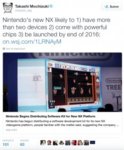I always thought it would make sense to include one handheld and some sort of a hub that let the portable consoles connect to it providing a larger display on a TV, multiplayer and more interesting controllers. Not only this ensures that companies (including Nintendo) will have easier time producing games on one hardware rather than two, but this'll also leaves the retailers more room to cram more units, games, accessories and amiibo to sell. I'm pretty sure that a lot of people aren't exactly fond of the idea to shell out around 500$ just to buy two different hardwares, so they could play everything Nintendo and co. has to offer. This is especially true when the 3DS install base is many times bigger than the Wii U would ever do. It begs the question on why there should be division between the home console and handheld, as the former itself is a long outdated concept since everyone in the world has gotten busier than before and comes with less fund to spare than before.
Although we saw Sony and Microsoft still managing to sell a rather impressive amount of home console units during the Wii and Wii U era, we're seeing many people, even the younger audience playing games on a mobile device that isn't even dedicated to gaming in first place, most likely due of the much stronger marketing and better overall value than the dedicated gaming companies could ever hope to reach their heights. However, I see there are concerns on preserving the low battery life of mobile phones unless they're close proximity to their home. It generally isn't a wise idea for an adult to spend time gaming with their mobile phone if they have to do some other stuff on their phone before they need to recharge the battery for some time, especially when they might get phone calls and such they'd expect the least. The same can be said for any tablet device, but not as highly concerning as the mobile phones do. That's when gaming handhelds become handy in the situation that would regularly occur in average Joe's life, therefore was the reason why 3DS had that huge advantage over the Wii U, and DS over the Wii.
Well, portability is one big thing, but still let's take a look on how Nintendo approached the Wii U development according to a AAA third-party developer and how it was marketed, which were probably the factors that largely contributed to being the second lowest selling Nintendo console of all times at the moment.
If
this old but insightful article meant anything to how development of a Wii U game fared, it effectively is harder and more time-consuming to do so with Nintendo as opposed to Sony and Microsoft. Remember all of those big-budget developers who were interested on the console before it was launched? Well, most of them are no longer that interested a bit after the launch and went for PS4 and even Xbox One, and it's still going to stay that way this year despite many of the well-known franchises have arrived (Mario Kart, Super Smash Bros., and the likes). Sure, there is a lot of support by the indie developers, but the situation still leaves Nintendo to do a herculean amount of work to make this console relevant.
A greatest way to get your words spreading in the ear of everyone about a console is invest money on a convincing marketing, yet Nintendo somehow goofed up on that part big time. The advertisements are much scarcer than their competitors, the unclear and unconvincing ways that Nintendo used to advertise the console itself and its games didn't exactly got your average Joe interested on buying it. For example, have you taken a look on the box of the Wii U console? The console main's attraction is to have a large controller with a resistive tactile-feedback screen, as advertised on the front of the box. Part of me thinks that the particular controller is overshadowing the console by being placed in front, which might have lead people to believe at first glance this might be a huge handheld that could be played anywhere like 3DS or other handhelds they already have, while the Wii U actually don't let them do so and have it tethered to its proximity. That's where the confusion settles in among uninformed consumers, which by the way consists a huge part of the gaming population that some of you might failed to realize the more hardcore gamers are a slim minority. I hope that Nintendo they will at least properly market NX worldwide, or else they would fade into obscurity once again.
I also noticed that there are some people still insisting that Nintendo would still follow the same old minimum 5 years cycle rule that the majority Nintendo consoles seemed to establish, but for me it was never properly explained why they tend to have this kind of life cycle, while other companies gave their hardware a shorter or longer one. I'm also reminding you again that Nintendo's HQ is going to be internally restructuring, and that the hardware teams are merged into one instead of two, making hardware development much easier this time around. So, the life cycle might work a bit differently in the future, if not more flexible than in the past. The HQ restructure will likely make a big difference in how Nintendo will operate in years to come to better serve to their customers, instead of stagnating. This is why I'm all for the upcoming NX, yet I still don't know much about it aside of it likely being a handheld/home console hybrid and rumours.

